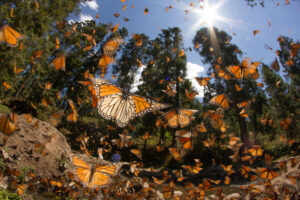Written by: Gail Fowler, an Extension Master Gardener with the Northern Shenandoah Valley Master Gardener Association, a unit of Virginia Cooperative Extension.

When fully opened, its soft gray cape, spotted with black polka-dots and trimmed with fine black lines, reveals a stunning red, black, and white pleat. A splash of bright yellow at the center pulls it all together.
If there were a fashion runway at the Ugly Bug Ball, the adult Spotted Lantern Fly (SLF) would certainly make a statement. But don’t judge this bug by its colors. Native to China, the SLF is an invasive pest that feeds on the sap of a wide range of fruit, ornamental and woody trees. As they feast, they excrete sticky “honeydew,” resulting in harmful black mold that impairs plant growth. Left unchecked, the SLF can cause serious damage to the country’s grape, orchard, and logging industries.
The SLF is a trickster. It looks different at each stage of its development. The nymphs have little in common with their dressed-up adult versions. Since only adult SLFs have wings — and even the adults tend to hop or jump rather than fly – SLFs have learned to thrive as stowaways, preferring to attach themselves, directly (or indirectly via egg masses) to cars, trucks, trains, boats. Hitchhiking is how these less-than-adept fliers have managed to spread their wings from Pennsylvania, where they were first detected in 2014, to Virginia, West Virginia, Maryland, Delaware, Ohio, Indiana, New York, New Jersey, Connecticut, and Massachusetts.
The SLF is truly indiscriminate when it comes to laying eggs. Any level surface will do. This includes outdoor garden equipment and furniture, trailers, and even children’s playsets. Some states have tried to curb the spread of SLF by enforcing quarantine rules, restricting the movement of outdoor materials in infested areas. It’s still not enough.
The U.S. Department of Agriculture in conjunction with the Department of Agriculture in each of the 11 states where SLF already has taken up residence needs your help to track and report community spread of SLF. This month, as temperatures begin to warm, tens of thousands of SLF egg masses deposited on trees, vehicles, grills, and other outdoor equipment will explode with instars (tiny black bugs with white dots). Knowing how to recognize the SLF in all its clever disguises is the first step to helping rid your community of these destructive bugs. The second step is learning how to stop the SLF from spreading.
As an Extension Master Gardener, I hesitate to give violent advice. But here it is: Until better management solutions are discovered, old-fashioned elimination tactics work best: scrape (egg masses), and squish, squash, swat, or stomp any living version of the SLF. Help save our forests and food crops from this pretty, ugly bug.





